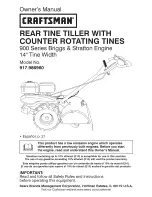
7
1.4 - Repair safety considerations
All installed parts must be maintained by the personnel in
charge, in order to avoid deterioration and injury. Faults and
leaks must be repaired immediately. The authorised technician
must have the responsibility to repair the fault immediately.
After each repair of the unit, check the operation of the
protection devices and record their correct operation in the
maintenance log.
Comply with the regulations and recommendations in unit
and HVAC installation safety standards, such as: EN 378,
ISO 5149, etc.
If a leak occurs or if the refrigerant becomes contaminated
(e.g. by a short circuit in a motor) remove the complete charge
using a recovery unit and store the refrigerant in mobile
containers. The compressors do not allow to transfer the
refrigerant charge and can be broken if they are used to pump
down. The refrigerant charge should not be transferred to
the high-pressure side.
Repair the leak, detect and recharge the circuit with the total
R-134A charge, as indicated on the unit name plate. Certain
parts of the circuit can be isolated. Only charge liquid
refrigerant R-134A at the liquid line.
Always ensure you are using the correct refrigerant type
before recharging the unit. Charging any refrigerant other
than the original type (R-134A) will impair machine
operation and can even lead to a destruction of the
compressors. The compressors operating with this refrigerant
type are lubricated with a synthetic polyolester oil.
RISK OF EXPLOSION:
Never use air or a gas containing oxygen during leak tests to
purge lines or to pressurise a machine. Pressurised air mixtures
or gases containing oxygen can be the cause of an explosion.
Only use dry nitrogen for leak tests, possibly with an
appropriate tracer gas.
If the recommendations above are not observed, this can
have serious or even fatal consequences and damage the
installation.
Never exceed the specified maximum operating pressures.
Verify the allowable maximum high- and low- side test
pressures by checking the instructions in this manual and the
pressures given on the unit name plate.
Do not unweld or flamecut the refrigerant lines or any
refrigerant circuit component until all refrigerant (liquid and
vapour) as well as the oil have been removed from chiller.
Traces of vapour should be displaced with dry nitrogen.
Refrigerant in contact with an open flame produces toxic
gases.
The necessary protection equipment must be available, and
appropriate fire extinguishers for the system and the
refrigerant type used must be within easy reach.
Do not siphon refrigerant.
Avoid spilling liquid refrigerant on skin or splashing it into
the eyes. Use safety goggles and safety gloves. Wash any spills
from the skin with soap and water. If liquid refrigerant enters
the eyes, immediately and abundantly flush the eyes with
water and consult a doctor.
The accidental releases of the refrigerant, due to small leaks
or significant discharges following the rupture of a pipe or
an unexpected release from a relief valve, can cause
frostbites and burns to personnel exposed. Do not ignore
such injuries. Installers, owners and especially service
engineers for these units must:
-
Seek medical attention before treating such injuries.
-
Have access to a first-aid kit, especially for treating
eye injuries.
We recommend to apply standard EN 378-3 Annex 3.
Never apply an open flame or live steam to a refrigerant
container. Dangerous overpressure can result. If it is
necessary to heat refrigerant, use only warm water.
During refrigerant removal and storage operations follow
applicable regulations. These regulations, permitting
conditioning and recovery of halogenated hydrocarbons
under optimum quality conditions for the products and
optimum safety conditions for people, property and the
environment are described in standard NF E29-795.
Any refrigerant transfer and recovery operations must be
carried out using a transfer unit. A 3/8” SAE connector on
the manual liquid line valve is supplied with all units for
connection to the transfer station. The units must never be
modified to add refrigerant and oil charging, removal and
purging devices. All these devices are provided with the units.
Please refer to the certified dimensional drawings for the
units.
Do not re-use disposable (non-returnable) cylinders or
attempt to refill them. It is dangerous and illegal. When
cylinders are empty, evacuate the remaining gas pressure,
and move the cylinders to a place designated for their
recovery. Do not incinerate.
ATTENTION: Only use refrigerant R134a, in accordance
with 700 AHRI (Air conditioning, Heating and Refrigera
-
tion Institute). The use of any other refrigerant may expose
users and operators to unexpected risks.
Do not attempt to remove refrigerant circuit components
or fittings, while the machine is under pressure or while it
is running. Be sure pressure is at 0 kPa and that the unit
has been shut-down and de-energised before removing
components or opening a circuit.
When the refrigerant circuit is opened for repair, it is
mandatory to plug all openings of the circuit if the repair
exceeds 30 minutes; this is to avoid moisture absorbed in
the circuit, especially in the oil. If the scheduled intervention
is longer, the circuit must be charged with nitrogen.
Do not attempt to repair or recondition any safety devices
when corrosion or build-up of foreign material (rust, dirt,
scale, etc.) is found within the valve body or mechanism. If
necessary, replace the device.
Do not install relief valves in series or backwards.
Summary of Contents for AquaForce 30XAV 1050
Page 39: ...39 ...








































